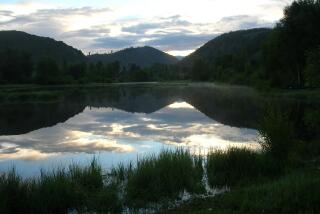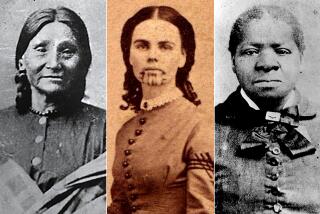Farewell to a Pioneer Grandmother
- Share via
The service had ended, and I bade the rest of the family goodby in the cemetery driveway. I took a quick walk in the cold December drizzle back to the new grave.
Nothing but good thoughts about my grandmother came flooding back as I stared at the headstone. I said my farewell in silence to the 92-year-old woman who was truly one of the West’s last pioneers.
Right up until the last few months of her life, Anna Powers, or Nan as she was known to family and friends, was as sharp as when she homesteaded 200 acres all by herself in southeastern Montana. Although her eyesight and hearing deteriorated over the past decade and she used a cane to “beat all the men away,” she loved to tell stories of her ranch near Ekalaka. And I loved to hear them.
She lived in a sod house out in “West Dakota,” as the locals called it, for five years, braving blizzards, droughts and isolation. President Woodrow Wilson signed the deed to the property over to her in 1918. She never sold the land, choosing instead to lease the property to a cattle-ranching family. “I just couldn’t sell it,” she once told me as we looked at the deed, with an official ribbon next to the President’s signature. “Not after all I went through for it. That’s to be kept in the family.”
It was 1914. Her father had died, and the family farm outside Attica, Ohio, had been sold. Nan packed her belongings in a trunk and headed for Toledo alone to look for work. But city life didn’t agree with the 19-year-old country girl, so she and her brother John hopped a train out to Big Sky Country to visit their older brother, Joe.
“Joe had gone out to homestead when he was 19--there were 13 years between us--and he really liked it.
“I had known about the land before I left Ohio: Joe knew of 200 acres out there near him. Some woman had been living there and failed to make final proof (under the Homestead Act) to the authorities in Washington. I guess she got homesick, and the land went back to the government.”
Homesteaders were required to make certain improvements on their land, such as farm so many acres or erect a dwelling--”mostly shacks no bigger than two outdoor johns.” They were also required to stay three out of five years on the property before the government would deed it to them. Nearly 1.7 million people homesteaded close to 300 million acres of land in the West.
“Well, Joe met me at the train station in Baker and let me stay at his place a while. (John went farther west, becoming a ranger at Yellowstone National Park.) Then Joe took me to Ekalaka by stagecoach. Oh, what a ride! When we came around this bend into Ekalaka, and--my lord--I took one look at that town and I wanted to go back east. I told Joe if there was another train leaving that night, I’d be on it.”
But her attitude changed over the next few months as she grew to know the 600 locals.
She landed a job waiting tables at an Ekalaka restaurant “where you could eat family style--all the lunch you wanted--for 35 cents” and moved into a 12-by-14-foot, one-room sod house on the ranch about eight miles south of town. Her brother and neighbors helped her add a second 14-by-20-foot room to it.
The walls were three feet thick, keeping her cool in the summers and warm in the winters. The roof was made of lumber--a rare commodity on the treeless prairie--and tar paper. Her home was the envy of the neighborhood: The doors and windows had glass panes. “One of the nicest things about the house was the window seats. You see, with walls that thick you had a nice seat at every window, once the glass was in.”
Joe built a small stable, where she kept a $50 saddle horse. “It was that horse or nothing.”
Water in the summertime was as scarce as shade. “I didn’t have a drop of water on the place. I used to hitch the horse up to a mud sled and put a barrel on it. I’d fill it up down at the spring about a mile away on the next property and then lug it back.”
She kept a rifle in the house for protection. A couple of rattlesnakes in the house and a coyote snooping through the barn late one evening were her only intruders.
Kerosene lamps provided light, and cooking was done on a stove that used the same fuel. Groceries and dry goods had to be ordered weeks in advance from Minneapolis, and perishables were kept in a ground cellar. “We paid about $2.50 for a 50-pound bag of white or brown sugar. You bought coffee in 25-pound bags, olives by the bucket and pickles by the gallon. You had to, because you never knew when the next shipment was coming in.”
Ekalaka kept in touch with the outside world via newspapers that arrived in town weekly, but “the saloon and the post office were where you’d find out what was going on.”
The first two autos appeared in town in 1918, and she had a chance to win one of them in a raffle. “This fellow came into the restaurant selling tickets, and I kept telling him I didn’t want to buy one, but he kept insisting. Finally he got the hint and left. He went down the street to the druggist’s and sold him that ticket. And wouldn’t you know it--that’s the ticket that won the car.” The winner gave her a ride in it as a consolation.
Autos were not the ideal mode of transportation back then, thanks to what she called the “beautiful” Carter County winters.
“One winter we had three feet of snow on the level (not drifted) and you could walk on it when it was frozen so hard. When you were out riding in a buggy or cart, the roads were only wide enough for one at a time. Every two miles there would be a place shoveled off where you’d pull in to let the other fellow pass. If you didn’t see him coming and met in the middle of nowhere, somebody had to back up.”
Disputes over who would do the backing were short thanks to the cold. “It would be as low as 40 below and I’d be out riding horseback into town. Of course it only felt like 25 below, you know.”
For recreation, she and a friend, a teacher who lived nearby, would take turns sliding down the hills in washtubs in the snow and mud.
More cosmopolitan entertainment could be found at Saturday night dances at the schoolhouse “where they had a real nice hardwood floor.” Men were charged a dollar to swing their partners--and pay for the band--while women brought baked goods as their cover charge. From 9 p.m. until 5 a.m. as many as 150 revelers would pack the one-room building and spill out on the grounds.
“People didn’t really worry about having jobs and making lots of money back then. You made enough to live on and that was plenty. Besides, there really wasn’t any place you could spend it in Ekalaka.”
She headed back east in 1919, working as a housekeeper for a wealthy Detroit auto family, a telegraph operator and a jewelry store clerk before marrying and starting a family. But she did visit her ranch a few times over the years.
And in the summer of 1970, my family and I swung by on a trip to Yellowstone. With Dad at the wheel and our camper trailer in town, we headed south out of Ekalaka, down the paved streets to the gravel roads, across the gravel roads to a dirt road and beyond the dirt road to a cow path. The sod house was gone, a victim of the elements, but the rest was as she said it would be: a foreboding, dry prairie with rocky hills in the distance. And a wind that never ceased.
More to Read
Sign up for Essential California
The most important California stories and recommendations in your inbox every morning.
You may occasionally receive promotional content from the Los Angeles Times.













